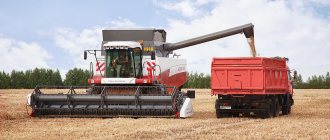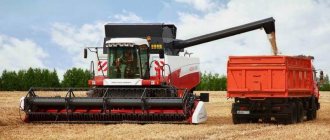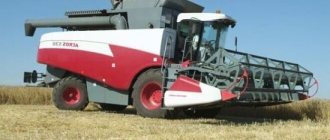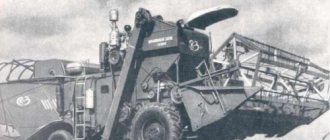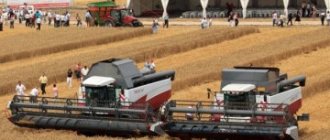Continuing the topic about agricultural machinery, I would like to talk about the “brainchild” of Rostov machine builders, the Akros 595 grain harvester. This is a relatively new engineering development, a design that is based on the experience of designing and releasing previous models.
Thanks to original technical solutions, the device can process over a thousand hectares per season, harvesting various plant crops.
Advantages and disadvantages
The main advantage of Akros agricultural machinery is its price. The design contains few borrowed parts from imported manufacturers, which significantly reduces manufacturing costs. Among other advantages I would like to note:
- Performance. ZUK is able to work with high-yielding crops without reducing the harvesting speed.
- Maintainability. There are no complex components in the grain harvester design. In addition, the proximity of the manufacturer and the availability of spare parts speed up repairs and reduce equipment downtime.
- Equipping the machine with efficient headers. Field implements specially designed for Akros are capable of high-quality cutting of plants, minimizing crop losses.
No matter how much the manufacturer wanted to, the ZUK could not be made completely trouble-free (and foreign analogues break down from time to time).
Frequent problems: destruction of bearings, drive belts and breakdown of the feeder conveyor. It must be said that these failures plague the entire Akros family, but apparently the manufacturer cannot strengthen the weak points.
Operation and Maintenance
The operating instructions specify the following types of maintenance:
- operational run-in;
- primary;
- secondary;
- monthly.
A set of measures for unit maintenance:
- Checking the pressure level in the tires of the driving wheels.
- Inspection of the fastening system. It is necessary to check the operation of the bearings, knife drive mechanism, pump hydraulic system, and diesel pipelines.
- Perform header adjustments.
- Inspect the technical equipment for any gaps.
- Check the tension of the belt and chains.
- Adjust all fastening nuts.
- Lubricate the elements in accordance with the schedule specified in the user manual.
- Check the level of working fluid in the hydraulic tank, radiator, motor, and battery.
- Adjust V-belt drives.
- Inspect the fan for damage.
Design features, main parameters
Harvesting “RSM 152” is a combination of several mechanisms, the common purpose of which is to harvest grain or row crops and separate plant matter from grains. Thus, the design of the machine includes a header, a threshing apparatus, a separator, a straw walker, and a storage hopper.
Table No. 1. Specifications
| Name | Meaning |
| engine's type | Cummins 6L TAA8.9 |
| Power, l. With. (kW) | 325 (241) |
| Weight (without header), kg | 14330 |
| Operating speed, km/h | 0-12 |
| Productivity, ha/h | 5,1 |
| Ground clearance, mm | 370 |
| Maximum turning radius (along the outer track of the steered wheels), m | 8,5 |
| Grain productivity per operating hour, t/h, | 18 (at least) |
| Fuel tank volume, l | 540 |
| Noise level in the workplace, dB | No more than 80 |
The feeder chamber of the grain harvester is equipped with an accelerator. The mechanism accelerates the plant mass before feeding it into the threshing unit, which increases the productivity of the device and reduces the load on the separator.
Motor
The effectiveness of the RSM 152 is largely determined by the capabilities of the diesel engine installed on it. Unlike the early Akros, the presented model is equipped with an imported engine.
This is an inline six-cylinder engine with liquid cooling. It is equipped with a turbocharger and an intermediate heat exchanger.
The use of this diesel engine made it possible to reduce fuel consumption by 15% compared to domestic ones. With a full tank, the grain harvester can work for 14 hours without refueling. Motor characteristics:
- Crankshaft speed - 2200 rpm.
- Cylinder volume - 8.9 liters.
- Torque - 1350 N∙m (at 1400 rpm).
- The average fuel consumption is 1.9 liters per ton of grain.
- Compliance with environmental standards - Euro-2.
Chassis, transmission
The power transmission of the grain harvester is made according to the hydrostatic principle. To select the speed mode, a three-stage range box is provided.
The first gear is intended for overcoming off-road conditions with unstable soil, the second is working (harvesting takes place on it), the third is transport, it is needed for moving on public roads.
The wheeled chassis was equipped with pneumatic tires. Tires of size 30.5LR32 are installed on the front axle, and 18-24 on the rear axle. The latter can rotate, providing the vehicle with maneuverability.
By the way, the steering drive is hydrostatic. The rotation of the hubs is carried out by a double-acting cylinder, which ensures the necessary accuracy of the mechanism and reduces the force applied by the operator to the steering wheel.
Dimensions
My first acquaintance with the device occurred in working conditions, when it was in the field. But even in open space, the dimensions of the RSM 152 impressed me.
The nine-meter wide-cut header, the transformable bunker roof and the unloading auger conveyor in the extended position look impressive. It must be said that unloading is possible at a speed of 90 l/sec, which allows you to empty the storage in less than 2 minutes.
Dimensions of the device without header:
- Length - 8.85 m.
- The width in the transport position is 3880 mm, in the working position with the unloading auger extended - 8.8 m.
- Height - 3940 mm.
- Wheelbase - 4000 mm.
- The track of the driving/driven wheels is 3100/2900 mm.
Video
Compared to the basic version (Akros 530), there were quite a lot of changes. Key transformations took place in the feeder chamber. The developers abandoned the receiving beater, which made it possible to process row crops without modifying the design of the feeder chamber. Together with the normalizing beater, an accelerating beater appeared in the design, leveling the grain mass before the phase of feeding into the threshing drum. The modernization increased throughput and reduced the load on the threshing drum.
News here.
Transformations also occurred in the design of the straw walker. The longitudinal arrangement of the grooves of the straw walker keys improved the passage of grain, and the increased length of the keys (by 100 mm) provided a greater amplitude of vibrations. Modernization has made it possible to increase the productivity of equipment in areas with high humidity.
Another innovation was the appearance of a single hydraulic connector. The modernized design simplified the installation and dismantling of the header and the replacement of adapters for various crops. The special design of the connector prevented soil and dirt from entering the hydraulic system.
Among the features of the Acros 595 model are:
- chopper with a fundamentally new technological scheme;
- accelerating beater in the inclined chamber;
- powerful 325-horsepower engine;
- enlarged 2-cascade cleaning system;
- electrohydraulic copying.
The main direction of use of the Akros 595 combine is harvesting fields of high and medium yields. The model works effectively in fields with high humidity and straw content. The combine can be used for harvesting cereal crops, sunflower, rapeseed, corn for grain, cereals and other crops (when equipped with special devices and adapters). The unique characteristics of the Acros 595 and the attractive price-performance ratio make this combine the best in its class.
Performance characteristics
The harvesting process begins with cutting off the plant mass. This is done by the header. Akros is equipped with a mechanism of its own design, called Power Stream. The header carefully cuts the plants with virtually no grain loss.
Mechanism parameters:
- working width - 5, 6, 7, 9 m;
- knife movement speed - 1180 strokes/min;
- drive - planetary gearbox;
- reel rotation speed - revolutions are synchronized with the speed of movement of the grain harvester.
The header is capable of changing its position relative to the ground, copying the terrain. The function allows you to increase productivity and quality of cleaning by increasing operating speed and reducing losses.
After cutting, the plant mass is sent along an inclined conveyor to the threshing unit. There, a drum with a diameter of 800 and a length of 1480 mm threshes the incoming material.
Its rotation can be adjusted for better separation of grains from the plant mass. The concave wrap angle is 130° and the total area is 1.38 m2.
To separate the grains, the threshed mass is sent for separation. The mechanism is a straw walker consisting of 5 movable keys 5.2 m long. The separation area is 6.3 m2.
Next, the grain is sent for cleaning. The process occurs under the influence of a powerful air flow, which blows out the light straw, allowing the final product to spill through the 5.2 m2 grates.
At the end of the cycle, the grain enters a storage bin with a volume of 9 m3. From the storage facility, the material is unloaded via screw conveyors into support vehicles.
Device
ACROS combine: device and main parts:
- Reel. This is a device through which the cut stems fall onto the header platform.
- Cutting apparatus. This is a part designed for cutting stems.
- Screw. It is used to move the cut grain mass towards the center and fingers.
- Feeder with conveyor. Passing through it, the stem enters the receiving chamber.
- Stone catcher. All the stones that fall out of the grain mass fall into it.
- Threshing drum. Its function is to process the ears.
- Deck and straw walker.
- Transport board.
- Fan and chaff sieve. They are necessary for cleaning grain from debris and straw.
- Straw chopper.
- Grain auger chamber. This is where the grain ends up after processing.
- Operator's cabin.
- Engine.
- Unloading type auger.
- Impact beater.
Engine
The first versions of the Akros combine were equipped with Russian engines YaMZ 236BE and YaMZ 236BE-2. The four-stroke diesel engine was distinguished by a safety margin of 20%, due to which it was characterized by maneuverability in difficult areas. Therefore, the unit has become reliable among Russian diesel engines.
Attention!
The engine, made in the shape of the Latin letter V, characterized by fuel injection and turbocharging, is currently installed on combines, tractors and trucks.
The YaMZ 236BE engine has a liquid cooling system with forced circulation. The device is equipped with a mechanical high-pressure fuel pump.
Engine characteristics:
- working volume – 11.15 l;
- rated power - 280 hp;
- number of cylinders – 6;
- cylinder diameter – 13 cm.
Later versions have a Cummins diesel engine with similar torque and power ratings.
Specifics of using Akros combines
Acros products are distinguished by good technical equipment and ease of use. The cabins of the combines are made using a special system, so they are vibration and noise insulating. Thanks to the central location, the view is 360°.
It is possible to operate the combine in any weather. A cooling system with additional fans is responsible for cooling the engine. Off-road travel is effortless thanks to thick tires with a deep herringbone tread pattern.
Attention! You can operate the machine even at night thanks to the presence of powerful LED headlights.
The drum design is made according to an original design, so grain harvesting is carried out quickly and with minimal losses. Configuration of systems and components is possible on the field during operation.
Combine harvester Acros 595 plus RSM 152
Acros 595 plus RSM 152 is a special agricultural equipment designed for harvesting ears, obtaining grain mass from ears, cleaning grains using an air mixture and storing the final product. The model is used for the most difficult tasks - operation on large areas with any indicators of straw content and crop moisture.
Acros 595 plus is a development of the Rostselmash brand, one of the leaders in the Russian agricultural machinery market. The manufacturer is represented by 13 branches located in Kazakhstan, Ukraine, Canada and other countries. The company regularly updates its line of models, refining previous versions and adding new solutions. This combine is the latest development, which has received a number of interesting improvements. Akros 595 plus is a true flagship of the series. In comparison with the Akros 580 model, the increase in power was 10%, in comparison with the basic Akros 530 – 30%. Advanced technological solutions have made it possible to significantly improve the quality of the resulting grain mass. Unique characteristics allow the combine to process more than 1000 hectares of area per season.
Purpose
versatility, comfort and significant productivity are qualities for which the Acros 595 plus PCM 152 is valued by farmers from all over the world. The combine is perfectly adapted to a variety of working conditions. The main area of use of the model is harvesting fields with medium and significant yields. special equipment is designed to work with cereal crops, corn, rapeseed, sunflower and cereal crops (with additional adapters). The excellent combination of cost and characteristics makes the combine one of the most popular in its category.
"RSM 152" Acros: Russian agricultural machinery on a global scale
Continuing the topic about agricultural machinery, I would like to talk about the “brainchild” of Rostov machine builders, the Akros 595 grain harvester.
This is a relatively new engineering development, a design that is based on the experience of designing and releasing previous models. Thanks to original technical solutions, the device can process over a thousand hectares per season, harvesting various plant crops.
